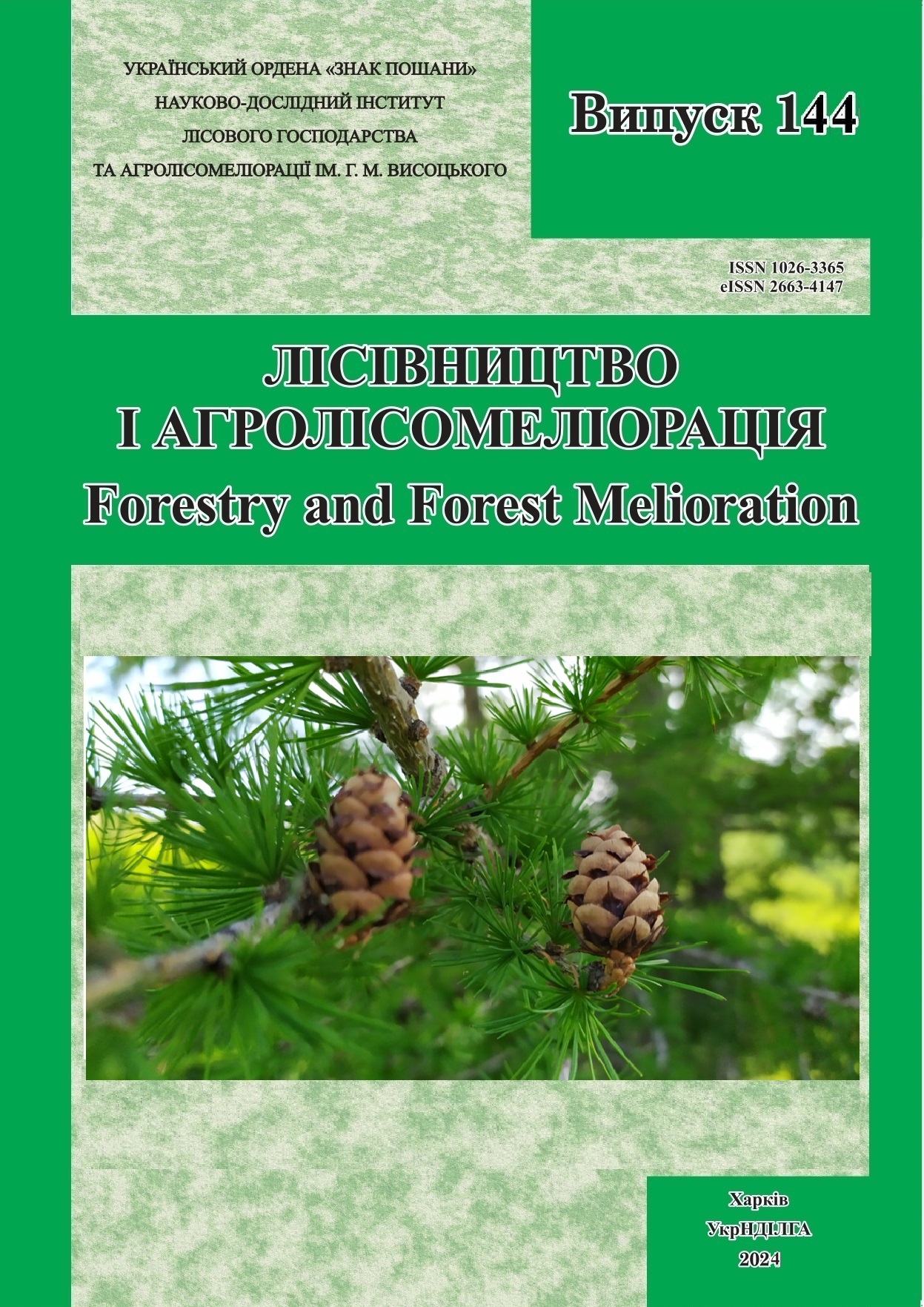Анотація
Досліджено біологічні особливості інвазійного виду жолудевої молі, або бластобазиса жолудевого (Blastobasis glandulella (Riley, 1871) (Lepidoptera: Blastobasidae), у насадженнях Західного Поділля та в камеральних умовах. Виявлено, що, окрім жолудів різних видів дуба (Quercus sp.), гусениці розвиваються в плодах гіркокаштанів (рід Aesculus) і деяких видів горіхів із роду Juglans. Личинки мають тривалий період розвитку, зимують у плодах і повністю з’їдають сім’ядолі. У міру поїдання одного плоду гусениці переповзають до іншого і за період свого розвитку пошкоджують кілька плодів, які втрачають схожість. Личинки заляльковуються як усередині плодів, так і з їхнього зовнішнього боку та в лісовій підстилці з квітня і майже до середини вересня. Виліт метеликів подовжений у часі й відбувається з другої половини травня до середини вересня. B. glandulella перешкоджає насіннєвому відновленню лісів, одержанню садивного матеріалу для лісових і міських насаджень та для продукції горіхівництва.
Посилання
Adamski, D. (2003) ‘A new Blastobasis associated with acorns and pecans in the southeastern and south central United States (Lepidoptera: Coleophoridae: Blastobasinae)’. Holarctic Lepidoptera, 7(2), pp. 51–53. Available at: http://www.troplep.org/Adamski-new-Blastobasis.pdf (Accessed: 15 May 2024)
Adamski, D. and Brown, R.L. (2022) ‘Larval, pupal, and adult morphology of the acorn moth, Blastobasis glandulella (Riley, 1871) (Lepidoptera: Gelechioidea: Blastobasidae)’. The Journal of the Lepidopterists' Society, 76(1), pp. 10–20. https://doi.org/10.18473/lepi.76i1.a2
Bidzilya, A.V., Bidychak, R.M., Budashkin, Yu.I., Demyanenko, S.A. and Zhakov, A.V. (2014) ‘New and interesting records of Microlepidoptera (Lepidoptera) from Ukraine’. Contribution 3, Optimization and Protection of Ecosystems.
Bystrowski, C. and Jakoniuk, H. (2022) ‘Occurrence of Blastobasis glandulella (Riley, 1871) (Lepidoptera: Blastobasidae) on sessile oak seed plantations in the RDSF in Zielona G?ra (Poland)’, in Skrzecz, I., Tkaczyk, M., Oszako, T. (eds.) Current problems of forest protection (25–27 October 2022, Katowice, Poland), Applied Sciences, 12(24), 12745. pp. 103–105.
Debouzie, D., Heizmann, A., Desouhant, E. and Menu, F. (1996) ‘Interference at several temporal and spatial scales between two chestnut insects’. Oecologia, 108, pp. 151–158. https://doi.org/10.1007/BF00333226
Dunning, C.E., Paine, T.D. and Redak, R.A. (2002) ‘Insect-oak interactions with coast live oak (Quercus agrifolia) and Engelmann oak (Q. engelmannii) at the acorn and seedling stage’, in Proceedings of the Fifth Symposium on Oak Woodlands: Oaks in California’'s Challenging Landscape. CA: Pacific Southwest Research Station, Forest Service, U.S. Department of Agriculture, pp. 205–218.
Gayt?n, ?., Van Dijk, L.J., Faticov, M., Barr, A.E., Tack, A.J. (2024) ‘The effect of local habitat and spatial connectivity on urban seed predation’, American Journal of Botany, e16333. https://doi.org/10.1002/ajb2.16333
Galford, J.R. (1986) ‘Primary infestation of sprouting chestnut, red, and white oak acorns by Valentina glandulella (Lepidoptera: Blastobasidae)’, Entomological News, 97, pp. 109–112.
GBIF | Global Biodiversity Information Facility (2024) Blastobasis glandulella Riley, 1871. Available at: https://www.gbif.org/species/9473121 (Accessed: 15 May 2024)
Hausenblas, D. (2007) ‘Zum Vorkommen von Blastobasis huemeri Sinev, 1993 in Deutschland (Lepidoptera, Blastobasidae)’, Mitteilungen des Entomologischen Vereins Stuttgart, 42, pp. 93–95. Available at: https://www.zobodat.at/publikation_articles.php?id=260263 (Accessed: 15 May 2024).
Hancock, E., Bland K. and Razowski, J. (2014) The moth and butterflies of Great Britain and Ireland. Vol. 5 (Part 2): Tortricidae: Olethreutinae. Leiden: Brill.
Kukina, O., Skrylnyk, Yu., Zinchenko, O. and Sokolova, I. (2023) ‘The first record of Blastobasis glandulella (Riley, 1871) (Lepidoptera: Blastobasidae) from Ukraine’, Entomological readings in memory of outstanding entomological scientists V.P. Vasylieva and M.P. Uncle, dedicated to the 110th anniversary of the birth of Academician of the National Academy of Sciences of Ukraine V. P. Vasiliev and prof. M. P. Dyadechka, pp. 128–131.
Landry, J.-F., Nazari, V., Dewaard J.R., Mutanen M., Lopez-Vaamonde C., Huemer, P. and Hebert, P.D.N. (2013) ‘Shared but overlooked: 30 species of Holarctic Microlepidoptera revealed by DNA barcodes and morphology’, Zootaxa, 3749(1), pp. 1–93. https://doi.org/10.11646/zootaxa.3749.1.1
Meshkova, V.L., Didenko, M.M., Raspopina, S.P., Bila, Y M. and Goroshko, V.V. (2024) Natural seed regeneration of European oak in the southern part of the Left-bank Forest-Steppe of Ukraine. Kharkiv: Fact. ISBN 978-617-8175-25-2.
Sokolova, I.M. (2023) ‘To the method of detection and study of biological features of the acorn moth Blastobasis glandulella (Riley, 1871) (Blastobasidae) in acorns and fruits of bitter chestnut’, in Plant protection and quarantine in the 21st century: problems and prospects. Materials of the 2nd International Scientific and Practical Conference, dedicated to the anniversary dates of the birthdays of outstanding entomological scientists, doctors of biological sciences, professors O. O. Migulin and O. V. Zakharenko.
Wenman, G. (2012) ‘Blastobasis huemeri Sinev, 1993, breeding in South West France’, Oreina, 20, pp. 9–11. Available at: https://oreina.org/artemisiae/biblio/docpdf/Wenman2012-820.pdf (Accessed: 15 May 2024)
Zepner, L., Karrasch, P., Wiemann, F. and Bernard, L. (2022) ‘ClimateCharts.net – an interactive climate analysis web platform’, International Journal of Digital Earth, 14, pp. 338–356. https://doi.org/10.1080/17538947.2020.1829112
Zinchenko, O.V., Sokolova, I.M., Skrylnyk, Yu.Ye., Borysenko, O.I. and Kukina, O.M. (2023) ‘New data on distribution and biology of Blastobasis glandulella (Riley, 1871) (Lepidoptera: Blastobasidae) in Ukraine’, The Kharkiv Entomological Society Gazette, XXXI(1), pp. 40–45. https://doi.org/10.36016/KhESG-2023-31-1-5

Ця робота ліцензується відповідно до Creative Commons Attribution 4.0 International License.

